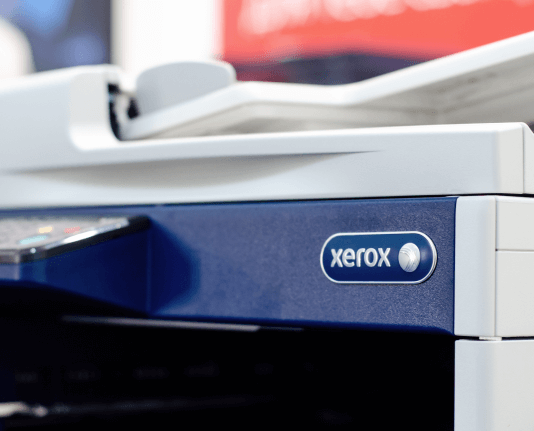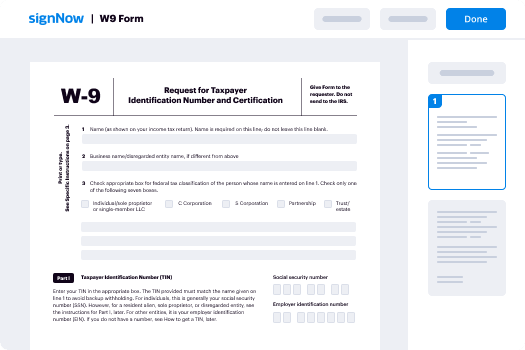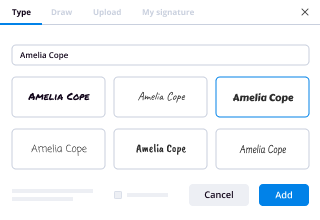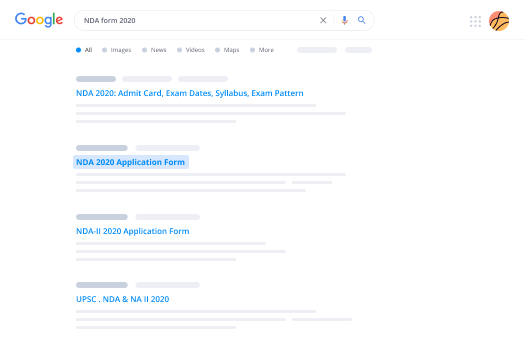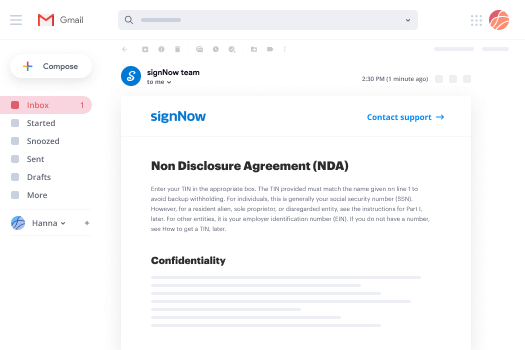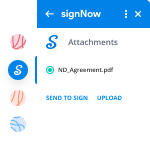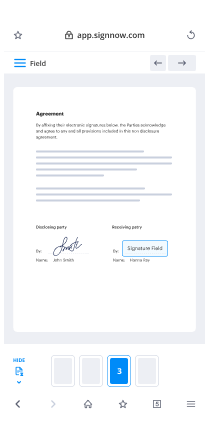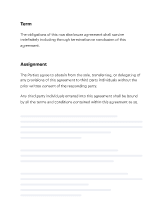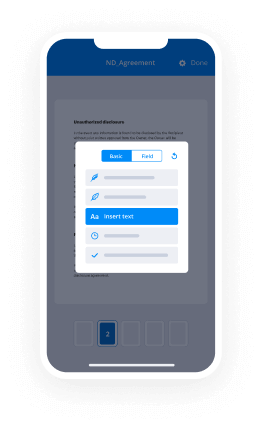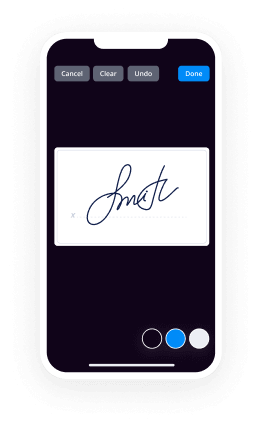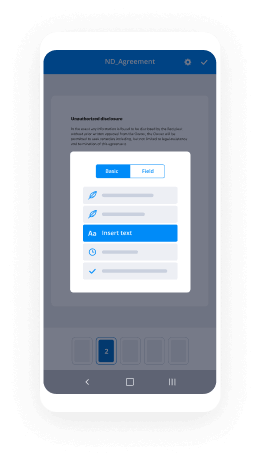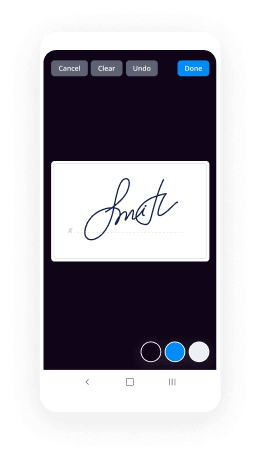Print eSignature Word Mac
Make the most out of your eSignature workflows with airSlate SignNow
Extensive suite of eSignature tools
Robust integration and API capabilities
Advanced security and compliance
Various collaboration tools
Enjoyable and stress-free signing experience
Extensive support
Keep your eSignature workflows on track
Our user reviews speak for themselves






How to mac print using airSlate SignNow
If you are seeking to improve your document management system, particularly for mac print activities, airSlate SignNow provides a variety of advantages. This platform streamlines the manner in which you handle, sign, and distribute documents, offering a dependable solution that serves enterprises of all sizes. With its easy-to-navigate interface and powerful functionalities, you can optimize your workflows and guarantee effective document handling.
Steps to mac print with airSlate SignNow
- Launch your web browser and go to the airSlate SignNow homepage.
- Create an account with a complimentary trial or log in if you already possess one.
- Choose the document you want to sign or circulate for signature and upload it.
- If you intend to utilize this document again, save it as a template for later use.
- Access your document to perform any necessary modifications, like adding fillable fields or incorporating information.
- Sign the document and include signature fields for all required signers.
- Click 'Continue' to set up and dispatch the eSignature invitation.
By using airSlate SignNow, organizations can witness a considerable return on investment due to its extensive feature set in relation to the funds spent. Its user-friendly design makes it straightforward for small to medium-sized businesses to adopt and expand without excessive complexity.
To conclude, airSlate SignNow is a superb tool for individuals aiming to optimize their mac print and document signing procedures. With clear pricing and outstanding 24/7 support, it's time to enhance your document management strategy. Register today and experience the advantages for yourself!
How it works
Rate your experience
-
Best ROI. Our customers achieve an average 7x ROI within the first six months.
-
Scales with your use cases. From SMBs to mid-market, airSlate SignNow delivers results for businesses of all sizes.
-
Intuitive UI and API. Sign and send documents from your apps in minutes.
A smarter way to work: —how to industry sign banking integrate
FAQs
-
What is airSlate SignNow's pricing for mac print services?
airSlate SignNow offers flexible pricing plans that cater to various business needs. You can choose from monthly or annual subscriptions, which include features like mac print functionality. Visit our pricing page to find the plan that best fits your organization and its document management needs.
-
How does airSlate SignNow simplify the mac print process?
With airSlate SignNow, the mac print process is streamlined to enhance user experience. The platform allows you to easily print signed documents directly from your Mac, ensuring a hassle-free workflow. This means you can manage and print documents quickly without the need for additional software.
-
Can I integrate airSlate SignNow with my existing Mac applications for printing?
Yes, airSlate SignNow seamlessly integrates with various Mac applications to enhance your printing capabilities. Whether you're using Microsoft Office, Google Workspace, or other popular tools, you can easily access the mac print feature for a smoother experience. This integration ensures that your document workflow remains efficient.
-
What features does airSlate SignNow offer for mac print users?
airSlate SignNow provides a range of features designed specifically for mac print users. These include customizable templates, bulk sending, and automated reminders, all accessible through an intuitive interface. These features help you manage your document signing and printing processes more effectively.
-
Is airSlate SignNow secure for printing sensitive documents on a Mac?
Absolutely! airSlate SignNow prioritizes security, ensuring that your sensitive documents are safe during the mac print process. The platform uses advanced encryption methods and complies with industry standards to protect your data. You can confidently print and send documents without worrying about unauthorized access.
-
How can I access mac print options within airSlate SignNow?
Accessing mac print options in airSlate SignNow is straightforward. Once you’ve signed a document, simply navigate to the print menu, select your printer, and choose the mac print option. The user-friendly interface guides you through the process, making it easy for anyone to print documents.
-
What are the benefits of using airSlate SignNow for Mac printing?
Using airSlate SignNow for Mac printing offers numerous benefits, including time savings and enhanced productivity. The platform allows you to manage all your document signing and printing needs in one place, reducing the time spent switching between applications. This efficiency can signNowly streamline your business operations.
-
Who are the 2013 Top Writers on Quora?
I am, strangely enough. My output has waned over the last year as I've become busier. But I'm happy to take the fleece. In the meantime, enjoy some of my greatest hits of the past year, most of which are not that great: Biology * Shan Kothari's answer to Is it a good idea to interbreed the various endangered tiger subspecies like the Sumatran, Malayan, Indo-Chinese, South China, Bengal and Siberian tigers so that they have more genetic variation? [ https://www.quora.com/Is-it-a-good-idea-to-interbreed-the-various-endangered-tiger-subspecies-like-the-Sumatran-Malayan-Indo-Chinese-South-China-Bengal-and-Siberian-tigers-so-that-they-have-more-genetic-variation/answer/Shan-Kothari ] * Shan Kothari's answer to Can giraffes swim? [ https://www.quora.com/Can-giraffes-swim/answer/Shan-Kothari ] * Shan Kothari's answer to Ecology: What do ecologists think of Lotka-Volterra? [ https://www.quora.com/Ecology-What-do-ecologists-think-of-Lotka-Volterra/answer/Shan-Kothari ] * Shan Kothari's answer to What is the future of big data in ecology? [ https://www.quora.com/What-is-the-future-of-big-data-in-ecology/answer/Shan-Kothari ] * Shan Kothari's answer to What is hermatypic coral? [ https://www.quora.com/What-is-hermatypic-coral/answer/Shan-Kothari ] Philosophy * Shan Kothari's answer to Why did Blaise Pascal not immediately understand the "which god" problem with his wager? [ https://www.quora.com/Why-did-Blaise-Pascal-not-immediately-understand-the-which-god-problem-with-his-wager/answer/Shan-Kothari ] * Shan Kothari's answer to Philosophy of Mind: What is functionalism? [ https://www.quora.com/Philosophy-of-Mind-What-is-functionalism/answer/Shan-Kothari ] * Shan Kothari's answer to Do ethical philosophers tend to be more ethical? [ https://www.quora.com/Do-ethical-philosophers-tend-to-be-more-ethical/answer/Shan-Kothari ] * Shan Kothari's answer to Can you be a philosopher and still believe in god? [ https://www.quora.com/Can-you-be-a-philosopher-and-still-believe-in-god/answer/Shan-Kothari ] * Shan Kothari's answer to What are the main differences between epiphenomenalism and materialist reductionism? [ https://www.quora.com/What-are-the-main-differences-between-epiphenomenalism-and-materialist-reductionism/answer/Shan-Kothari ] * Shan Kothari's answer to What has philosophy contributed to society in the past 50 years? [ https://www.quora.com/What-has-philosophy-contributed-to-society-in-the-past-50-years/answer/Shan-Kothari ] Other: * Shan Kothari's answer to What are some famous pictures that ruined people's lives? [ https://www.quora.com/What-are-some-famous-pictures-that-ruined-peoples-lives/answer/Shan-Kothari ] * Shan Kothari's answer to Why is it common liberal policy to reject Social Darwinism despite wholeheartedly embracing evolution? Why this contradiction? [ https://www.quora.com/Why-is-it-common-liberal-policy-to-reject-Social-Darwinism-despite-wholeheartedly-embracing-evolution-Why-this-contradiction/answer/Shan-Kothari ] * Shan Kothari's answer to Who are the best or most famous Christian poets? [ https://www.quora.com/Who-are-the-best-or-most-famous-Christian-poets/answer/Shan-Kothari ] * Shan Kothari's answer to What are the most impressive intellectual achievements completed by persons under 20 years old in terms of the influence, magnitude, depth, scope, creativity, or difficulty of the achievement? [ https://www.quora.com/What-are-the-most-impressive-intellectual-achievements-completed-by-persons-under-20-years-old-in-terms-of-the-influence-magnitude-depth-scope-creativity-or-difficulty-of-the-achievement/answer/Shan-Kothari ] * Shan Kothari's answer to What is it like to attend a REU? [ https://www.quora.com/What-is-it-like-to-attend-a-REU/answer/Shan-Kothari ] * Shan Kothari's answer to What directors chose the same people to work with time and time again, in any roles, and who are these people? [ https://www.quora.com/What-directors-chose-the-same-people-to-work-with-time-and-time-again-in-any-roles-and-who-are-these-people/answer/Shan-Kothari ]
-
Who are the Top Writers on Quora?
Balaji Viswanathan (பாலாஜி விஸ்வநாதன்)If ever you want to learn something new on daily basis.please switch on the notifications from Balaji Vishwanath sir.Awdhesh Singh (अवधेश सिंह)In case if you are wandering for the best views from an intellect,he is always on cards !Gopalkrishna VishwanathIf ever you wanted a simple answers with so much of life experience,don't forget to follow Gopalkrishna Vishwanath sir!Abhimanyu SoodIf you want to hear a story,please don't miss this guy.. he is my fav!User-9248814863030902883In case if you crave for travel experiences,this guy is fantastic ! Sinless bloke indeed.Sean KernanSarhad ChoudharyIn case if you are eager to know son and grandson of quora ..don't forget these wonderful guys !Vishak RamanIf you want to keep reading and getting lost.he is nice to read! Unique guy I must tell you !Dhawal BarotIf you seem very interested in shortest feel good stories,this guy tops the list!Loy MachedoWhenever you feel low,reading his answers can make you feel better!The list continues !And if ever you want to read some stupid answers follow this guy! Raghavendra MThanks for reading
-
What is the birthday gift I can give to my best friend who is a bibliophile?
How about one of these?An Annotated Bibliography of Typography, Letterpress Printing and Other Arts of the Bookby David S. Rose • Five Roses PressThe explosion of desktop-based, digital pre-press technology at the end of the twentieth century brought to a wide audience the previously specialized world of typography. Modern type design applications give users the ability to create new digital typefaces from the imagination, to recreate classic faces that are otherwise unavailable in digital form, and to adapt existing faces for specific needs.For those artisans who still hand-set and print with traditional letterpress technology, a dozen type foundries continue to provide a constant stream of classic metal faces. And for designers who combine the two worlds by printing letterpress from photopolymer plates, the options are unlimited.As with any powerful tools, the more one knows of the history behind them, the better able one will be to utilize them. The books listed here are just a few of hundreds that have been written on the subject of typography over three centuries, but they will provide a solid start for reading in this area.While many of the works listed are classics in the field, not all of them are currently in print. Those that are not available from the publisher (or from reprint houses such as Dover Publications) may often be found at antiquarian dealers who specialize in the field of Books about Books. A number of such dealers are listed at the end of this bibliography, and the rapid adoption of the Internet by antiquarian book dealers now means that most of these books are a simple click away. Overviews of Printing TypesPrinting Types: An Introduction by Alexander Lawson with Dwight Agner [Boston: Beacon Press, 1990] is a short (120 pages) easy-to-read overview that is exactly as advertised: an introduction. For over thirty years, Lawson has taught a course in the history of printing types at the Rochester Institute of Technology School of Printing, and this book grew out of his need for a simple handbook on the subject for his students. It is a well designed and illustrated inexpensive paperback, and would probably be your best bet if you have a casual interest in the subject and only want to read one book. The latest edition, brought current through 1990, covers electronic typography as well.Printing Types: Their History, Forms, and Use by Daniel Berkeley Updike (1860-1941) [New York: Dover, 1980 reprint of the second (1937) edition]. This is the classic work in the field of typographic history. Updike was a leader in the revival of traditional printing typefaces in the United States, and was the founder of the Merrymount Press (1893). A series of lectures he gave at Harvard from 1910-1917 served as the basis for Printing Types, which was first published in 1922. This Dover reprint is in two volumes, 618 pages of text plus 300 unnumbered illustrations. As Dover says in the jacket notes, "Printing Types presents the standards, the landmarks in typography that anyone connected with printing must know. In its mammoth, illustrated coverage, it is without a doubt the definitive guide to the subject.Letters of Credit: A View of Type Design by Walter Tracy [Boston: David Godine, 1986. 224 p, ill.] A beautiful and profusely illustrated step-by-step demonstration of type-design aesthetics that traces the beginnings and the path of modern-day typesetting.Fine print on type; the best of Fine print magazine on type and typography by Charles A. Bigelow, Paul Hayden Duensing, Linnea Gentry [San Francisco: Fine Print: Bedford Arts, 1988] is an excellent selection of articles from Fine Print magazine, the late indispensable periodical with which anyone concerned with type should be familiar. Each issue was designed by a different typographer, printed by letterpress and included scholarly articles, typographic overviews, reviews, and notices of new books on typography. Fine Print was published quarterly through about 1990, after which the publication led cliff-hanging existence as various groups and institutions tried to save it. While long gone, a final retrospective index is currently nearing production, and will also be a must-get.Typographical periodicals between the wars; a critique of the Fleuron, Signature, and Typography by Grant Shipcott [Oxford: Oxford Polytechnic Press, 1980. xiv, 111 p. :ill.]. These classic periodicals (particularly the Fleuron) were to their time what Fine Print was to typography and book design today, but because of the ferment in the world of design during the 20s and 30s and because of their illustrious contributors, they had a much greater effect on the typography of the time.Type and Typefaces by J. Ben Lieberman [New Rochelle: The Myriade Press, 1978] is an alternative to the Lawson book, but rather less accurate, bigger (142 pages, 8 1/2 x 11, hardcover) and harder to find. Ben Lieberman was an enthusiastic amateur printer and the father of the American Chappel movement of hobby printers. This book is an exuberant look at the history, classification, identification, and personalities of typography. It includes examples of over 1,000 type faces, and is well illustrated. Lieberman was not a scholar, but if you like unabashed 'boosterism,' you might find this book fun to read, despite its errors of both omission and commission.History and Development of Lettering and Letter formsThe 26 Letters by Oscar Ogg [New York: Thomas Y. Crowell, 1948]. A nicely done book by a well known American calligrapher, tracing the evolution of the alphabet from prehistoric times to the invention of printing. 250 pages, well illustrated.Letters by James Hutchinson [New York: Van Nostrand Reinhold, 1983]. A stylishly designed, very readable history of alphabets, writing, and printing types.The History and Technique of Lettering by Alexander Nesbitt [New York: Dover Publications, 1957]. A thorough history of type design from its origin through the mid-twentieth century, this book covers some of the same material as the Ogg book, but includes much more information on the development of letter forms since the invention of printing. It is written from an artist's perspective, and has a how-to section on lettering.The Alphabet and Elements of Lettering by Frederic W. Goudy [New York: Dover Publications, 1963. Reprint of 1952 University of California edition]. This falls somewhere between the Ogg and Nesbitt books, from Goudy's unique perspective as the most prolific type designer of the twentieth century.Roman Lettering by L.C. Evetts [New York: Taplinger, 1979] includes a character-by-character analysis of the letters on Trajans Column in Rome, which have served for centuries as one of the foundations of roman (serif) letter design. Evetts also includes charts showing the evolution of the roman alphabet through the centuries. Handsome lettering, with little text to clutter the presentation.An ABC Book: ABC of Lettering and Printing Types by Erik Lindegren [New York: Pentalic, nd ca. 1976]. A survey of type, calligraphy, and design, with examples of work from all periods, with an especially strong representation of lettering by Swedish, English, German, and American scribes and designers. A lively, well-designed introduction to letters.Writing, Illuminating and Lettering by Edward Johnston [New York: Taplinger, 1980]. The comprehensive calligraphy manual by the man who led the twentieth century revival of calligraphy. Johnston's influence on English, American and German lettering and design was immense.History of Lettering by Nicolete Gray [Boston: David Godine, 1987. 256 p].Type Designs from Various PeriodsArt of the Printed Book, 1455-1955; masterpieces of typography through five centuries from the collections of the Pierpont Morgan Library, New York by Joseph Blumenthal, (1897- ) [New York: Pierpont Morgan Library; 1984. Boston, MA: D.R. Godine, xiv, 192 p. : ill.]. Available both in hardcover and paperback, this collection by one of the great printer/scholars of the century is a must have for anyone interested in original source material. More than a hundred full pages facsimiles from the Morgan Library provide an instant overview of the development of typographic design from Gutenberg to the mid-twentieth century.Anatomy of a Typeface by Alexander Lawson [Boston: David R. Godine, 1990, 428 pages] A great book from one of the leading typographic experts of the late twentieth century, this substantial work examines a wide variety of typefaces in great detail, and explains why they look the way they do. An excellent reference work for the designer and printer that will both improve your eye for the detail of font design and inform the choices you will make in specifying and setting type yourself.Selected Essays on Books and Printing by A. F. Johnson [Amsterdam: Van Gendt, 1970]. Johnson was a scholar at the British Museum, and along with Daniel Berkeley Updike and Stanley Morrison was considered one of the experts in the field of typographic history. This lovely, massive (500 pages), and very expensive collection of some of his writings from 1927-1957 concentrates primarily on the typographic work of sixteenth century calligraphers and printers.A view of early typography up to about 1600 by Harry Carter [(The Lyell lectures 1968) Oxford, Clarendon P., 1969. xii, 137 p. 45 plates. illus., facsims., col. map].A history of the old English letter foundries; with notes, historical and bibliographical, on the rise and fall of English typography by Talbot Baines Reed, 1852-1893 and A. F. Johnson [Folkestone: Dawsons, Reissued 1974 xiv, 400 p., fold. leaf : ill., facsims].Notes on a Century of Typography at the University Press, Oxford, 1693-1794 by Horace Hart [Oxford, Clarendon Press, Reissued 1970 (1st ed. of 1900 reprinted) with an introduction and additional notes by Harry Carter. ix, 16, xvi, 203 p., plate. illus. facsims]. History of the types and typography of the Oxford University Press, generally regarded as the preeminent scholarly press in the western world.Nineteenth Century Ornamented Type Faces by Nicolete Gray [Berkeley: University of California Press, 1976]. Reprint of a classic from 1938, this large format 240 page work is the definitive book on its subject.American Wood Type, 1828-1900 by Rob Roy Kelly [New York: Da Capo Press]. Notes on the evolution of decorated and large wood types, and comments on related trades. As with the Nicolete Gray book, this is the definitive work in its field. The book was issued in several editions, of which this (paperback) is the least expensive.The Typographic Book 1450-1935 by Stanley Morrison and Kenneth Day [Chicago: University of Chicago Press, 1963]. A lush, expensive, visual treasury of almost 500 years of typography, including 357 plates.American typography today by Rob Carter [(New York: Van Nostrand Reinhold, 1989. 159 p. : ill. (some col.)].The Liberated Page Edited by Herbert Spencer [San Francisco: Bedford Arts, 1987]. An anthology of the major typographic experiments of the 20th century, as recorded in Typographica magazine.TypographyA Typographic Workbook: A Primer to History, Techniques, and Artistry by Kate Clair. A good place to start for a basic grounding in typographic design.The Elements of Typographic Style by Robert Bringhurst. A highly acclaimed, although somewhat more advanced, standard work in the field.The Crystal Goblet; sixteen essays on typography by Beatrice Warde [Cleveland and New York: World Publishing Company, 1956]. From a major woman in the field of typography come some thought-provoking pieces, including the famous analogy that gave the collection its name. Mandatory reading for would-be typographers.The Case for Legibility by John Ryder [London: The Bodley Head, 1979] "Not a typographer's manual nor a 'do-it-yourself' guide to book design, it is a personal statement of great sincerity and conviction by a distinguished practitioner of the art." Ryder also wrote “Printing For Pleasure”, one of the touchstones of the avocational letterpress printing movement.Better Type by Betty Binns [New York: Watson-Guptill, 1989. 192 p]. A trade book from the early days of the desktop publishing revolution that shows by copious examples the subtle differences in relationships between typefaces, letters, and spaces. From the preface: "This book systematically trains designers to make these fine discriminations, with the aim of specifying text type that is not only readable, but also beautiful and expressive." Only released in this one edition, and not readily available, but a nice book nevertheless.Introduction to Typography by Oliver Simon [London: Faber & Faber, 1945]. Not a bad place to start. This edition is out of print, but there has been at least one reprint in recent years. Simon's introduction is designed for the layman, and discusses many of the basic principles and theories of designing with type.First Principles of Typography by Stanley Morrison [Cambridge: at the University Press, 1951]. An important book from the man who designed Times Roman for the London Times.Asymmetric typography by Jan Tschichold [(Translated by Ruari McLean) New York, Reinhold Pub. Corp. 1967. 94 p. illus. (part col.) facsims]. Jan Tschichold (1902-1974), a well-known typographer, caused many people to rethink 'conventional' theories of typography when this seminal work was published in the mid-60s. Whether or not you agree with his approach, this book is required reading and will widen your typographic horizons.An essay on typography by Eric Gill [1st U.S. ed. Boston: D.R. Godine, 1988]. A classic typographic manifesto on the art and craft of letterforms from the designer of Gill Sans and the famous typography of London Underground.Typography, A Manual of Design by Emil Ruder [Niederteufen, Switzerland: Arthur Niggli Ltd, 1977. 3rd Edition]. A fascinating, disciplined, and very Swiss analysis of typography and letterforms. Ruder's discussion and illustration of the importance of white space in letter forms and graphic designs is excellent background reading.Report on the typography of the Cambridge University Press by Bruce Rogers [Cambridge, Cambridgeshire: University Printer, 1950. viii, 32, (3) p. : ill.]. Bruce Rogers (1870-1957) is regarded by many as having been the greatest typographer and book designer of the twentieth century. After World War II he was commissioned by the Cambridge University Press to undertake a thorough review of all of the Press' publications and standards. The resulting Report had a major impact not only on the C.U.P., but also on the general typographic theory in both Britain and the U.S.Designing with type; a basic course in typography by James Craig and Susan E. Meyer [Fourth. ed. New York: Watson-Guptill Publications, 1999. 176 p]. A modern 'how-to' book, often used as the primary textbook in college design courses, that is available at many large bookstores and graphic arts dealers.Finer Points in the spacing & arrangement of Type by Geoffrey Dowding.Book DesignMethods of Book Design: The Practice of an Industrial Craft by Hugh Williamson. An excellent book, not only for the author's typographical observations, but also as a comprehensive survey of printing at the height of letterpress.The Design of Books by Adrian Wilson. A classic on the design, layout, and typography of traditional pages and books, written by a great letterpress printer in 1967. Bookmaking: Editing, Design and Production by Marshall Lee Originally written primarily about letterpress in 1965, this 500+ page work has recently been re-issued in a greatly updated third edition for the computer era.Printing Poetry: A workbook in typographic reification by Clifford Burke. A very informative work on this subject that also applies to other letterpress printing. Issued in an edition of only 1000.Type DesignersTwentieth Century Type Designers by Sebastian Carter [New York: Taplinger Publishing Company, 1987]. An excellent look at the people behind the type faces, with in-depth profiles of designers such as Goudy, Morrison, Zapf, etc.Typologia; studies in type design & type making, with comments on the invention of typography, the first types, legibility, and fine printing by Frederic W. Goudy (1865-1947). [Reissued 1977. Berkeley: University of California Press, xviii, 170 p.: ill.; 24 cm.]. Written by the most prolific type designer of the 20th century [creator of, among others, the eponymous Goudy Oldstyle], this reprint of the 1940 edition discusses the history, function, and meaning of type, and gives some very good insights into how a type designer works.Jan Tschichold: typographer by Ruari McLean [Boston: David R. Godine, 1975]. This puts Tschichold's career and writings in the context of developments in society around him. It is informative and thought-provoking on its own, and serves as useful background to his writings on the subject.Manuale Typographicum; 100 typographical arrangements with considerations about types, typography and the art of printing selected from past and present, printed in eighteen languages by Herman Zapf [Frankfurt, New York: Z-Presse, 1968]. Herman Zapf is known to most desktop typographers primarily for giving his name to the Zapf Dingbat font. He is, in addition, one of the most respected and creative typographers and type designers of the century, who created not only the Dingbat and Zapf Chancery fonts, but also Optima and many other faces. Manuale Typographicum is a breathtaking 'tour de force,' consisting of 100 broadsides about type design in a wide variety of faces and styles. Superb as a source of inspiration and example.Herman Zapf and His Design Philosophy by Herman Zapf, Introduction by Carl Zahn [New Haven: Yale University Press, 90 color plates]. While the Manuale shows the master at work, this volume is a discourse on Zapf's insights into type design. An excellent book.Edward Johnston by Priscilla Johnston [New York: Pentallic, 1976]. This biography of the twentieth century's most important calligrapher, written by his daughter, traces his career and influence. Unlike many printing books, this one is a delightful read.Of the Just Shaping of Letters by Albrecht Dürer [New York: Dover Publications, 1965. (reprint of the Grolier Club translation of 1917)]. Originally part of Dürer's theoretical treatise on applied geometry, here is the source for those famous capital letters set against a gridded background.Champ Fleury by Geoffrey Tory, translated into English and annotated by George B. Ives [New York: Dover Publications, 1967. (reprint of the Grolier Club translation of 1927)]. The other famous humanistic alphabet similar to the one discussed in the Dürer book, but this is the one with the letters shown against naked human bodies in addition to the grid system.Pioneers of modern typography by Herbert Spencer [Cambridge, Mass.: MIT Press, 1983. Rev. ed. 160 p. : ill.].Typeface Reference WorksAmerican Metal Typefaces of the Twentieth Century by Mac McGrew [New Castle, Delaware: Oak Knoll Books, 1994, 2nd rev, ed. 376 p. : ill]. The definitive work on the subject, and an essential reference for both graphic designers and current letterpress printers. Currently in print from the publisher.The Encyclopedia of Type Faces, 4th Edition by W. Pincus Jaspert, W. Turner Berry, and A. F. Johnson [Poole, Dorset: Blandford Press, 1983]. A standard, comprehensive reference in the field, this work is a detailed listing of over 1,000 faces, arranged by name, with full information on their history, designers, etc. Although even after several editions it has numerous uncorrected errors (dates, foundries, names, even occasionally an incorrect specimen shown) it is still a required reference work on the subject.A.T.A. Type Comparison Book by Frank Merriman [Advertising Typographers Association of America, 1965]. An indispensable handbook for identifying typefaces. Hundreds of faces are grouped together by design, making it easy to find the one you want. Still in print, possibly in a more recent edition.Graphics Master 7: Workbook of reference guides & Graphic Tools for the Design, Preparation & Production Print and Internet Publishing by Dean Phillip Lem [Los Angeles, Calif.: D. Lem Associates, 2000. 7th ed. 158 p. : ill. (some col.)]. Although it covers much more than just type design, and is fairly expensive, this is one of the most important and continually useful reference work that a desktop designer and/or publisher should have.Font & Function [Mountain View, California: signNow Systems] was signNow's biennial catalog of their latest font offerings. But this tabloid size, four-color publication was also quite a bit more. It included articles on typographic history, the background to many signNow PostScript fonts, technical information and a graphic listing of over 1500 signNow fonts. While it is no longer being published, back issues are available from a number of sources.The typEncyclopedia; a user's guide to better typography by Frank J Romano [New York: R.R. Bowker Co., 1984. xii, 188 p. : ill.].Type and typography; the designer's type book by Ben Rosen [New York: Van Nostrand Reinhold Co., 1976 Rev. ed. 406 p. : ill.].History of PrintingA Short History of the Printed Word by Warren Chappell [Boston: Nonpareil Books (David Godine), 1980]. A once-over-very-lightly in 240 pages of large type, hitting the highlights in the development of type, printing and bookmaking.Five Hundred Years of Printing by S. H. Steinberg [Baltimore: Penguin Books, 1974]. A 400-page small-print paperback which is still in print, this covers Gutenberg through the early 20th century. Steinberg's style is a little dry. Since his death, the book (starting with the third edition) has been edited by James Moran.A Dictionary of Book History by John Feather [New York: Oxford University Press, 1986, 278 pp] is a concise one-stop reference, in alphabetical order, to topics including bibliography and bibliographical terminology, the history of printing, the physical history of the book (including typography, binding, etc.) and book collecting. It has over 650 articles ranging from a few lines to several pages, and covers the ground pretty thoroughly. Although not a classic work (and, indeed, poorly designed itself as a book), it serves as a very handy reference to the history of books. An expensive purchase at the original price of $45, it is often available on remainder for about $10.The Making of Books by Seán Jennett [New York and Washington: Frederick A. Preager, 1967]. A good overview of the entire art and craft of the book, including a little history and a fairly detailed examination of every stage of the process. If you are interested in books in general, this is a good place to start. Out of print, but rather ubiquitous at second-hand and antiquarian dealers.The Book: The Story of Printing & Bookmaking by Douglas C. McMurtrie [New York: Oxford University Press, 1943]. Almost 700 pages of large type devoted to the history of the book, by one of the most prolific writers in the field. Easy to read, anecdotal, and illustrated. Although out of print, it is not particularly scarce and, if you can find it, probably the quickest way to get up to speed on printing history.Letterpress Printing InstructionIntroduction to Letterpress Printing by David S. Rose.: [New York: Five Roses Press, 2003, 32pp.] The complete 21st century Getting Started Guide to everything you need to know about acquiring a press, finding supplies, learning to print, and setting up your very own letterpress shop. (Note: this indispensable little reference gets first place on the list because it was written by [ahem] the author of this very bibliography. A fully hyperlinked electronic version with up to date sources can be downloaded from www.fiveroses.org/intro.htm)General Printing by Glen U. Cleeton and Charles W. Pitkin.: [Bloomington, Ill: McKnight & McKnight Publishing Company, 1941-1963, 195pp.] Probably the best all-around introductory book for traditional letterpress printing, this manual is profusely illustrated with detailed and useful photographs. It is the one most recommended on the Letpress list, and several members personally knew the authors. Copies of the book are readily available in both paperback and hardcover.The Practice of Printing by Ralph W. Polk (in later editions, together with Edwin W. Polk) [Peoria, Illinois: The Manual Arts Press, 1937-1945; later editions Charles A. Bennett & Co., 1952-1964, 300+ pp]. The most ubiquitous letterpress printing manual of the twentieth century. This is the standard, in print for over 40 years, from which many current letterpress printers first learned in school print shop classes, and is a good basic reference for the letterpress printer. Although out of print, it is readily available, in one or another of its many editions, from most book arts dealers and online sources. In later years, it was distributed by the Kelsey Co. as the advanced printing manual for their mass-market presses. By 1971 it was updated to de-emphasize handset type, and was re-issued as "The Practice of Printing: Letterpress & Offset". If you are primarily interested in letterpress printing, try to get one of the earlier editions.Platen Press Operation by George J. Mills [Pittsburgh, Carnegie Institute of Technology, 1953, 150 p. illus.] This manual is the first choice of letterpress cognoscenti who are printing on platen presses, and serves as the missing "owner’s manual" for traditional platen presses such as Chandler & Price, Gordon, Pearl and other floor-mounted job presses. It should be read in conjunction with one of the above books, which provide more thorough coverage of hand type-setting and composition. This invaluable book is still available, in a reprint of the 1959 edition, from NA Graphics.Printing Digital Type on the Hand-Operated Flatbed Cylinder Press by Gerald Lange (Second Edition). California: Bieler Press, 2001 This is one of the few letterpress manuals currently in print, and the only one specifically addressing both Vandercook proof presses (the gold standard for current fine letterpress printers) and photopolymer plates. This book is the authority on the technologies of "modern" limited edition letterpress printing. Subjects covered include digital type and computer practices; letterpress configuration; photopolymer plates, flat-bases, and processing equipment; photopolymer plate-making; plate registration and travel; impression; cylinder packing and makeready; presswork; ink and inking; press operation and maintenance, as well as an updated listing of manufacturers and distributors. Newly included with this edition are troubleshooting guides to problems encountered during the processing and printing of photopolymer plates.Printing on the Iron Handpress by Richard-Gabriel Rummonds is the most comprehensive book ever published on the subject, and is still in print from Oak Knoll Press. (Note that "handpress" here means something specific when it comes to letterpress printing, and doesn't refer to ordinary hand-operated presses such as a Kelsey or a Pilot.) Precise techniques for printing on the handpress are presented in lucid, step-by-step procedures that Rummonds perfected over a period of almost twenty-five years at his celebrated Plain Wrapper Press and Ex Ophidia. In tandem with more than 400 detailed diagrams by George Laws, Rummonds describes every procedure a printer needs to know from setting up a handpress studio to preparing books for the binder. The author also maintains a constantly updated web-site to accompany the book.Printing for Pleasure, A Practical Guide for Amateurs by John Ryder [published in multiple editions from 1955-1977, in England and the US, by publishers including Chicago: Henry Regnery Co., (1977) and London: The Bodley Head (1976) This is still in print from The Bodley Head in the UK or Oak Knoll Books in North America]. A lovely, classy, little (12 mo) book, both pleasing to look at and inspirational for the novice amateur printer. This introductory work gives a light overview of the hobby of letterpress printing on both sides of the Atlantic, covering how to choose a press, type, paper and ink, as well as planning, design and production. A good place to start if you are just considering taking up this avocation, and a nice place to come back to every now and then to remind you why you are still printing.A Composition Manual: PIA Tools of Industry Series by Ralph W. Polk, Harry L. Gage et al. [Printing Industries of America 1953, 4to, 311 pp., index, biblio., 433 pps] A really excellent tutorial and reference work, sponsored by the printing industry trade association as the definitive manual for apprentices. It is a thorough overview of the entire typesetting and proofing end of the business that took four years and several experts to write. Because it was published in 1953, it came out just at the inflection point between hot and cold type, and is a fascinating final masterwork from an industry that feels the winds of change approaching. In addition to very detailed and well-illustrated tutorials on hand-setting and proofing metal type, it includes surprisingly useful overviews and illustrations of all the other composition-related tools of the shop, including Elrod, Ludlow and Monotype casters. To quote from the Forward, "The industry recognized the need for a manual containing basic principles of good typography that are fundamental to the presentation of the printed word, irrespective of whether that word is composed by hand, by machine, by photo-typesetting or by some yet unnamed method of the future…"I.T.U. Lessons in Printing [Indianapolis: International Typographical Union, 1927-1972, Various paginations] Published in many editions across half a century, these ten volumes were created by the printing unions as the standardized training course for American printers. While not as elegantly written or produced as many of the other letterpress manuals, these thousands of pages cover just about everything the journeyman printer was supposed to know, eventually encompassing Unit One (Elements of [Letterpress] Composition) through Unit Ten (Photocomposition, Ruling and Pasteup). Along the way is detailed information on topics including Display Composition, Imposition and Lockup, Trade Unionism, Linotype Operation, Design, and even English ("because English is a 'reasoning' subject which may have caused the student difficulty in school."). The first volume, covering the history of printing through typesetting and a proofing, is probably the most useful one for the modern letterpress printer. The original edition of 1927, written by John H. Chambers, was replaced by a much better text in the 50's that was almost certainly ghost-written by Ralph W. Polk, who also wrote the even better manual on behalf of the employers, as well as his own manuals (see above).Printing For School And Shop by Frank S. Henry [New York: John Wiley & Sons 1917, B&W photos and drwgs 318pp] Subtitled "A Textbook for Printers' Apprentices, Continuation classes, and for General Use in Schools" and updated with another edition in 1944, this was the original vocational course textbook which was eventually supplanted for the most part by Polk. Nevertheless, it provides detailed technical instruction and illustrations and—particularly in the later edition—can still serve as a useful learning tool for today's printer.The Essentials of Printing by Frank S. Henry [New York: John Wiley & Sons 1924, B&W drwgs 187pp + index] Subtitled "A Text-book for Beginners" and half the length of the preceding book. "It develops that there is an insistent demand for a shorter text, one that shall cover only the absolute essentials of printing...this volume attempts to present to the novice, in sequence, the operations necessary to the production of a piece of printed matter." Useful and relatively short, but somewhat outdated (even for letterpress!)Printing as a Hobby. By J. Ben.Lieberman [New York: Sterling Publishing Co. & London: Oak Tree Press, 1963. 128 p. Index.] is the brash, bigger, and less restrained American counterpart to the quintessentially British book by Ryder. Lieberman was an enthusiastic amateur printer, and this book is an exuberant well-illustrated pitch for his hobby. The author was not a scholar (nor particularly an aesthete), but if you like unabashed 'boosterism,' you might find this book fun to read, despite its errors of both omission and commission (not unlike his later book, Type and Typefaces, described above.)Printing, A Practical Introduction to the Graphic Arts by Hartley E. Jackson [New York; McGraw-Hill, 1957, 8vo., 286 pages]. Organization and use of the type case, hand setting, use of the platen press, and basic binding, with short sections on linoleum blocks, silk screen and photography in this industrial arts text. Not as good as Polk, but more than acceptable as an apprentice course book.Graphic Arts by Frederick D. Kagy [Chicago: The Goodheart-Willcox Co., Inc., 1961, 8vo, 112 pps.] Another (and probably the last) of the high-school vocational textbooks designed for once-over-lightly printing classes included as part of a longer graphic arts program, this short book gives a simple but well-illustrated quickie introduction to hand type-setting and platen press printing in about twenty pages. Nowhere near as comprehensive as many of the others, but certainly better than learning through pure trial and error.Introduction to Printing, The Craft of Letterpress by Herbert Simon, [London: Faber and Faber, 1968]Getting Started in Hand Printing & Binding by Van Waterford, [TAB Books, Blue Ridge Summit, Pennsylvania, 1981]Other Book ArtsHand Bookbinding: A Manual of Instruction by Aldren A. Watson. A clear, thorough, inexpensive introduction to hand binding.The Papermaker's Companion: The Ultimate Guide to Making And Using Handmade Paper by Helen Hiebert. Extensive step by step instructions.How to Marbleize Paper: Step-By-Step Instructions for 12 Traditional Patterns by Gabriele Grunebaum. A slim, inexpensive, but useful paperback.Practical Typecasting by Theo Rehak. The ultimate and definitive book on the subject, by the dean of American typefounders.Miller's Collecting Books by Catherine Porter. A modern, illustrated guide to all aspects of book collecting.BibliographiesA Typological Tally compiled by Tony Appleton [Brighton, (T. Appleton, 28 Florence Rd., Brighton, Sussex BN1 6DJ), 1973. 94 p. ill.]. Thirteen hundred writings in English on printing history, typography, bookbinding, and papermaking, compiled by one of the world's top dealers in the field.A Bibliography of Printing with Notes and Illustrations by F. C. Bigmore and C. W. H. Wyman [London: Oak Knoll Books, 1978]. Universally known as "Bigmore and Wyman," this is to printing bibliographies what Updike is to books about printing types. Published in 1880 (editions since then have been reprints) B&W provides excellent commentaries on just about every book that had been written on the subject as of the year it was published.Book Dealers/Publishers Specializing in Typography and the Book ArtsOak Knoll Books, ABAA 310 Delaware St. New Castle, DE 19720 USA tel:302-328-7232fax:302-328-7274 www.oakknoll.com email: oakknoll@oakknoll.comThe Veatches Art of the Book P.O. Box 328 140 Crescent Street Northampton, MA 01061 tel: 1-413-584-1867 fax: 1-413-584-2751 www.veatches.com email: Veatchs@veatchs.comFrances Wakeman Books 2 Manor Way, Kidlington, Oxford OX5 2BD, UK tel: +44 (0)1865 378316 fax: +44 (0)1865 378934 www.fwbooks.com email: info@fwbooks.comThe Bookpress Ltd. 1304 Jamestown Road Williamsburg, Virginia 23185 USA tel:(757) 229-1260 fax:(757) 229-0498 email: bookpress@widomaker.comTimothy Hawley Books 915 S. Third St. Louisville, KY 40203 U.S.A. tel: 502-451-3021email: hawleybk@home.comFrits Knuf Antiquarian Books P.O.Box 780, Oss NB, Netherlands, 5340 AT. tel: +31 412 626072. fax: +31 412 638755 email: info@books-on-books.comColophon Book Shop 117 Water Street Exeter, NH, 03833 tel: 603-772-8443www.colophonbooks.com email: colophon@nh.ultranet.comNA Graphics Attn: Fritz Klinke P.O. Box 467 Silverton, Colorado 81433 tel: 970-387-0212fax: 970-387-0127 email: nagraph@frontier.netDavid R. Godine, Publisher 9 Hamilton Place Boston, MA 02108-4715 tel: (617) 451-9600fax: (617) 350-0250 www.godine.com email: info@godine.comPeachpit Press 1249 Eighth Street Berkeley, CA 94710 tel (800) 283-9444 tel (510) 548-5991www.peachpit.comDawson's Book Shop 535 North Larchmont Blvd. Los Angeles, CA, 90004 tel: (213) 469-2186Many thanks to Howard Gralla, Alvin Eisenman, Robert Fleck, Kathy Schinhofen, Chuck Rowe, Earl Allen, Susan Lesch, Kathleen Tinkel, Michael J. Boyle, John Horn, Chris Simonds, Fritz Klinke, Roberta Lavadour, David Norton, Tom Parson, David Goodrich and the many members of the Letpress Internet mailing list for their suggestions before and during the compilation of this bibliography.An earlier version of this bibliography was originally published by Aldus Corporation in conjunction with their release of the Fontographer type design application. That version was, in turn, adapted and expanded from an earlier annotated checklist by the same author prepared for members of the MAUG Forums on Compuserve.Copyright © 1988-2014 by David S. Rose david@fiveroses.org The current version of this bibliography is always available online athttp://www.fiveroses.org/bibliog... and hyper-linking to it is encouraged. For any other publication inquiries, please contact the author. Revision: August 20, 2003 / December 18, 2014
-
Where can you design a book cover and backpage for free?
Here are the main players in DIY book cover design:Downloadable SoftwaresignNow: A high-end program for a wide variety of graphic design projects, not all inclusive to books. Creative, marketing and document management solutionsCost: Runs on subscription for about $10-$50/month.Microsoft Word: A high-end desktop program commonly used for creating book manuscripts. Microsoft - Official Home PageCost: About $50 to $360BookCoverly: A downloadable program specifically for creating high-quality ebook and print book covers. ISBN generator and spine width generator. Templates included with the Signature version, one template included with the Lite version. Both Mac & Windows compatible. www.bookcoverly.comCost: Lite: $47 • Signature: $97(Full disclosure: My own program)~~~~~~~~~~~~~~~~~~~~~~~~~~~~~~~~~~~~~~~~~~~~~~~~~~Web ApplicationsFREE Open Source: Most are for ebooks only, however Gimp supports print books.Canva: A free platform for designing a variety of materials. Easy to create e-book covers with many elements. Upgrade at $12.95/month for more design elements. Amazingly Simple Graphic Design SoftwareCost: There is a limited free version, or you can pay a subscription for premium features.Online Publishers: There are a few larger book printers that offer their own cloud based design app. For example, Blurb offers design service that is contingent upon using their somewhat pricey publishing services. Amazon has their own integrated book design app that is available free or at a small cost, but they have exclusivity rules.
-
How was the PDF format created?
I was there for the whole thing.It was the 90's and signNow was doing well. In addition to the Systems department which handled the Postscript business there was an Applications group which had Photoshop and Illustrator. John Warnock had the idea that every document that was ever printed, or ever would be printed, could be represented in a document. This was not an unreasonable idea since Postscript was designed for this purpose and signNow also had some code from Illustrator that would handle the fonts and graphics and code from Photoshop to display images. So, Warnok started a project (the Carousel project) on his own initiative to pursue his idea that eventually the whole Library of Congress could be represented in an archival electronic format.In the beginning he could only get part time help from programmers in the applications division - Mike Pell, Ken Grant, Mike Diamond. The project was progressing slowly so the head of the division (Eric Zocker?) started a search for a new programmer to handle the project full time. Alan Tracey Wootton had transitioned from programming at JPL to full time programming and was looking to leave LA and be more professional in Silicon Valley. He got the job and moved to Cupertino. Soon there was a demo and then a team developed to produce UI for the various platforms - Mac, Windows, DOS, and 'nix. The demo code progressed into cross-platform code to handle most of the internal data structures to support the UI projects. There were also people writing print-drivers to create documents through the printing process on all platforms. By this point the original demos were re-written into a file format that would contain the fonts, vector graphics, and images - this would be the second file format for the project. However, there were requirements that were not being met. Requirements like forward and backwards compatibility, streaming large documents through a printer driver where the printer driver has no idea how many pages there will be, and opening a 1000 page document and being able to jump directly to the 500th page without reading the whole file.Peter Hibberd had written a demo of an 'object oriented file format' so Richard Cohn and Alan Wootton went to work trying to adapt his work for use on the Carousel project. After many weeks of struggle it was decided that adapting his work was going to be more work than writing new code and that some of the 'object oriented' concepts were not applicable since it was finally becoming obvious that a key-value format was going to be part of the solution. This was the third file format. Bob Wulff, the manager of the project, told Richard and Alan to 'go away' and to not come back until there was a file format! The next Monday Richard and Alan started meeting at Richard's house in Menlo Park instead of going to work in Mountain View (where Google is now). By the end of Thursday, Richard and Alan had described data structures and concepts for a file format on many pieces of paper. Alan went home, pulled 4 overnights in a row and came back to signNow on Monday with the fourth file format written and working in the current code. This file format became known as PDF.
-
What are some good businesses that can be started with a very small capital?
I recommend that anyone looking to test the entrepreneurial waters give e-commerce a start. You can actually sell goods without ever owning them.I got started with E-Commerce when I was just 13, buying custom bicycles and selling all of the parts separately.Later I realized that I could sell just about anything without owning it at all. When a customer would place an order with me, I would get their money and use it to place an order with my supplier straight to my customer’s house.The difference in price and cost is my profit to keep. This is a business model known as dropshipping.A customer places an order on my website, I then buy much cheaper from a supplier and ship the order straight to my customer’s house.Keys to success:Start with one product (or a very small niche selection, if you must). Remember, Amazon started with Books on the internet.That flagship product should cost you less than $10, and sell for $29. In my experience, $30 is the maximum strangers are willing to spend with a stranger on the internet, with no recommendations from trusted sources or other social proof.Most people stress over what they will sell. The truth is, it’s all about angle. Super generic products are totally fine, when combined with the right audience.That last point is very, very important. I’ll share an idea I had the other day to help you better understand—I recently left a job that provided a company car. I’m out on my own for the first time, and despite making more money now, I’m still stressed over losing my steady, predictable income.So, I’m driving my sister’s old Lexus SUV. I love it.Leather interior, good gas mileage, has a little more get up and go…But the ONLY audio input is a cassette player!!So, I put in a little Casette-to-Auxiliary adapter that I sell through my B2B dropship business.I connected that device to another product I sell B2B— bluetooth-to-auxiliary adapter…I connected my phone via bluetooth, and voila!! I was playing Spotify wirelessly to/through a cassette deck!To my surprise, the audio quality was actually EXCELLENT.These two devices cost $6 combined.Find out what cars only have tape/cd decks and no auxiliary, and figure out how to target owners of those cars. Sell the combo for $29.BAM. Hungry audience, fantastic margin.Craigslist? Facebook ads?I haven’t fleshed that part out yet.Go ahead, steal my idea :)
Trusted esignature solution— what our customers are saying
Get legally-binding signatures now!
Related searches to Print eSignature Word Mac
Frequently asked questions
How do i add an electronic signature to a word document?
How do you sign financial documents in pdf?
What does e-mail message box have lock sign?
Get more for Print eSignature Word Mac
- How Can I Sign Maryland Temporary Employment Contract Template
- How Can I Sign Montana Temporary Employment Contract Template
- How Can I Sign Ohio Temporary Employment Contract Template
- Sign Mississippi Freelance Contract Online
- Sign Missouri Freelance Contract Safe
- How Do I Sign Delaware Email Cover Letter Template
- Can I Sign Wisconsin Freelance Contract
- Sign Hawaii Employee Performance Review Template Simple
Find out other Print eSignature Word Mac
- Ardagh group sa form f 1a received 03012017 160709
- Hereinafter referred to as grantor does sell convey and quitclaim unto form
- New jersey housing ampampamp mortgage finance agency form
- Grantor does hereby convey sell bargain and warrant unto as trustee of form
- Hereinafter referred to as grantor do hereby convey unto form
- How to prepare ampampamp record a quit claim deedhome guides form
- Real estate deed forms downloadable fill in the blank
- Accordance with the applicable laws of the state of iowa form
- Accordance with the applicable laws of the state of iowa and form
- With all improvements located thereon lying in the county of state of iowa form
- Hereinafter referred to as grantors do hereby convey unto hereinafter form
- In and for county iowa form
- Trade names recorder office polk county iowa form
- Chapter 1186 rcw disclaimer of interests form
- Payable with this contract shall be refunded to owner within thirty 30 days of the date of form
- Subcontractors notice of claim of lien individual form
- Position available the county auditors office is seeking form
- Injury law category archivespage 6 of 87justia form
- County state of iowa form
- Small claims court procedures judiciary of virginia form

